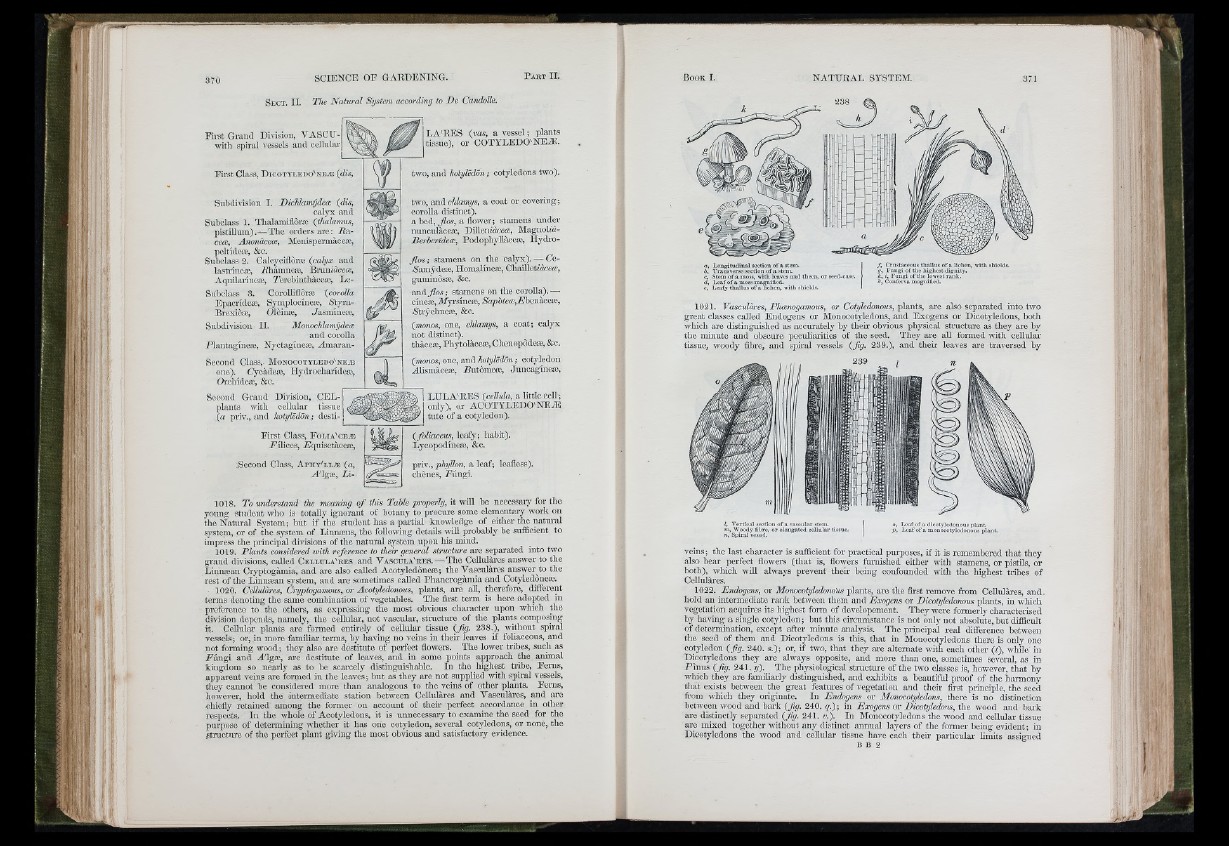
S ect. II. The Naturai System according to De Candolle.
First Grand Division, VASCU-
with spiral vessels and cellulai*
Ffrst Class, D icottledo'ne„e (dis.
Subdivision I. Dichlamydece (dis,
calyx and
Subclass 1. Tlialamìftòrai (thalamus,
pistillum).— The orders are: i?a-
cece, Anonàcece, Menispermàccic,
pcltidece, &c.
Subclass 2. Calcyciflòraì (calyx and
lastrinese, i/hanincie, Bmnidceo?,
Aquilarineai, 7ercbintliacc£e, Lc-
Subclass 3. Corolliflorie (corolla
Epacrideai, Symplocineai, S'tyra-
Brexiòaì, Olein®, Zasminea),
Subdivision II. Monochlamydece
and corolla
Plantaginefc, Nyctagincas, Amaran-
Second Class, MonocotyT/Edo'ne^e
one). Cycade®, Hydrocliaridca3,
Oi'chideis, &c.
Second Grand Division, CEL-
plants with cellular tissue
(a priv., and kotylëdôn ; desti-
Eirst Class, F olia' ceæ
Filiccs, Fquisetàceæ,
.Second Class, Aptit'llæ (a,
Ælgæ, Xi-
LA'RES (vas, a vessel ; plants
tissue), or COTYLEDO'NEÆ.
two, and hotyledön; cotyledons two).
two, and chlamys, a coat or covering;
corolla distinct).
a bed, ßos, a flower; stamens under
nuneuUiceas, Dilleniace«, Magnolià-
Berberideoe, Podophyllàceæ, Hydroß
o s ; stamens on the calyx). — Ge-
Sixmÿdeæ, Homalincæ, ChailletiùcciP,
guminôsæ, &c.
and ß o s ; stamens on the corolla). —
ciiicæ, ikfyrsineoe, »Sapàtea?,Fbenàceæ,
S'trÿchncæ, &c.
(monos, one, chlamys, a coat; calyx
not distinct).
tliàceæ, Phytolàceæ, Chenopôdeæ, &e.
(monos, one, and kotylëdôn ; cotyledon
Alismàccoe, Futômooe, Juncagineæ,
n LU LA 'E E S fellula, a little cell-,
only), or ACOTYLEDO'MEAS
tute of a cotyledon).
(foliaceus, leafy; habit).
Lycopodineoe, &c.
priv., phyllon, a leaf; leafless),
chones, Fungi.
1018. To understand the meaning o f this Table properly, it will be necessaiy for the
young student who is totally ignorant of botany to procure some clemcntaiy work on
the Natural System ; but if the student has a partial knowledge of either the natural
system, or of the system of Linnæus, the following details will probably be sufficient to
impress the principal divisions of the natural system upon his mind.
1019. Plants considered with refo'ence to their general structure are separated into two
grand divisions, called Cellltla'res and Vascula'res.— The Cellul^es answer to the
Linnæan Cryptogàmia, and are also called Acotyledôneæ; the Vasculàres answer^to the
rest of the Linnæan system, and are sometimes called Phancrogàmia and Cotyledôneæ.
• 1020. Cellulàres, Cryptogamous, or Acotyledonous, plants, are all, therefore, different
tenns denoting the same combination of vegetables. The first ten n is here adopted in
preference to the others, as expressing the most obvious character upon which the
division depends, namely, the cellular, not vascular, stracture of the plants composing
it. Cellular plants are formed entirely of cellular tissue (^fig. 238.), without spiral
vessds; or, in more familiar terms, by having no veins in their leaves if foliaceous, and
not fonning wood; they also are destitute of perfect flowers. The lower tribes, such as
F ù n g i and Ælgæ, are destitute of leaves, and in some points approach the animal
kingdom so nearly as to be scarcely distinguishable. In the highest tribe. Ferns,
apparent veins are formed in the leaves ; but as they arc not supplied with spiral vessels,
they cannot be considered more than analogous to the veins of other plants. Ferns,
however, hold the intermediate station between Ccllulai-es and Vasculàres, and ave
chiefly retained among the former on account of their perfect accordance in other
respects. In the whole of Acotyledons, it is unnecessaiy to examine the seed for the
purpose o.f dctennining whether it has one cotyledon, several cotyledons, or none, the
^tractui'e of the perfect plant giving the most obvious and satisfactory evidence.
<1, Longitudinal section of a stem.
b. Transverse section of a stem.
c. Stem o f a moss, with leaves an d tlieca,
d . Leaf o f a moss magnified.
«, Lea(y th a llu s o f a lichen, with shields.
/ , Crustaceous th a llu s o f a liciien, with shields.
¡7, Fungi of tl!c liighest dignity.
A, t, Fungi of t!ie lowest rank.
k . Conferva magnified.
1021. Vasculares, Phcenogamous, or Cotyledonous, plants, arc also separated into two
great classes called Endogens or Monocotyledons, and Exogens or Dicotyledons, both
which are distinguished as accurately by tlicir obvious physical stracture as they are by
tbe minute and obscure peculiarities of the seed. They are all fonned with cellular
tissue, woody fibre, and spiral vessels ( fg . 239.), and their leaves are traversed by
239
I, Vertical section o f a vascul.ar stem.
m. Woody fibre, o r elongated c ellu lar tissue,
n. Spiral vessel.
veins; the last character is sufficient for practical pui-poses, if it is remembered that they
also bear perfect flowers (that is, flowers iuraished either with stamens, or pistils, or
both), wliich will always prevent thefr being confounded with the hie:hest tribes of
Cellularcs.
1022. Endogens, or Monocotyledonous plants, are the first remove from Cellulares, and.
hold an intermediate rank between them and Exogens or Dicotyledonous plants, in which
vegetation acquires its highest foim of developement. They were fonnerly characterised
by having a single cotyledon; but this circumstance is not only not absolute, but difficult
of determination, except after minute analysis. The principal real difference between
the seed of them and Dicotyledons is this, tliat in Monocotyledons tliere is only one
cotyledon (fig. 240. s.); or, if two, that they ai*e alteraate with each other (i), while iii
Dicotyledons they ai-e always opposite, and more than one, sometimes several, as in
P in u s (fig. 241. y). The physiological stracture of the two classes is, however, that by
which they are familiarly distinguished, and exhibits a beautiful proof of the hm-mony
that exists between the great features of vegetation and thcir first principle, the seed
fi-om which they originate. In Endogens or Monocotyledons, there is no distinct.ion
between wood and bark (fig. 240. q.)-, in Exogens or Dicotyledons, the wood and bai-k
are distinctly separated (fig. 241. y.). In Monocotyledons the wood and cellular tissue
are mixed together without any distinct annual layers of the former being evident; in
Dicotyledons the wood and cellular tissue have each thefr particular limits assigned
B B 2
I !
ta